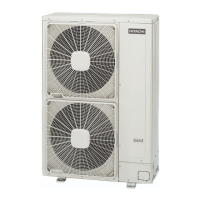4.2.2 Precautions in the event of gas refrigerant leaks
7KHLQVWDOOHUVDQGWKRVHUHVSRQVLEOHIRUGUDIWLQJWKHVSHFL¿FDWLRQVDUHREOLJHGWRFRPSO\ZLWKORFDOVDIHW\FRGHVDQGUHJXODWLRQVLQ
the case of refrigerant leakage.
C A U T I O N
• &KHFNIRUUHIULJHUDQWOHDNDJHLQGHWDLO,IDODUJHUHIULJHUDQWOHDNDJHRFFXUUHGLWZRXOGFDXVHGLI¿FXOW\ZLWKEUHDWKLQJRUKDUPIXOJDVHVZRXOGRFFXU
LID¿UHZHUHLQWKHURRP
• ,IWKHÀDUHQXWLVWLJKWHQHGWRRKDUGLWPD\FUDFNRYHUWLPHDQGFDXVHUHIULJHUDQWOHDNDJH
Maximum permitted concentration of HFCs
The refrigerant R410A (charged in the outdoor unit) and the
refrigerant R134a are incombustible and non-toxic gases.
+RZHYHULIOHDNDJHRFFXUVDQGJDV¿OOVDURRPLWPD\FDXVH
suffocation.
The maximum permissible concentration of HFC gas according
to EN378-1 is:
Refrigerant Maximum permissible concentration (kg/m
3
)
R410A 0.44
R134a 0.25
The minimum volume of a closed room where the system is
installed to avoid suffocation in case of leakage is:
System combination Minimum volume (m
3
)
4-6 HP 7.6
The formula used for the calculation of the maximum allowed
refrigerant concentration in case of refrigerant leakage is the
following:
R
— = C
V
R: Total quantity of refrigerant charged (kg)
V: Room volume (m³)
C: Refrigerant concentration
If the room volume is below the minimum value, some effective
measure must be taken account after installing to prevent
suffocation in case of leakage.
REFRIGERANT AND WATER PIPING
PMML0340B rev.1 - 03/20168

